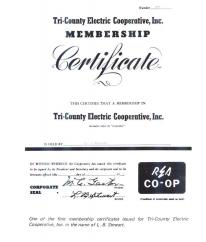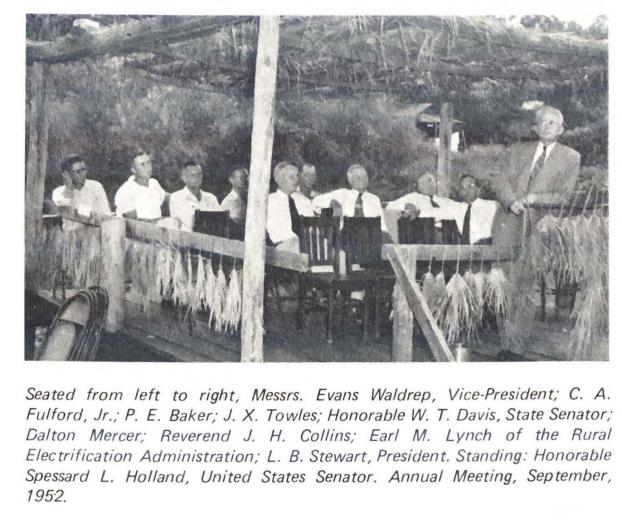Franklin Delano Roosevelt was inaugurated March 20, 1933 as America was in the middle of the Great Depression. On April 8, 1935, Congress passed the Emergency Relief Appropriation Act conferring sweeping power upon the President to battle the forces of the Great Depression. The 1935 Census showed that 90 percent of rural America’s farms, ranches and homes were without electricity.
May 11, 1935, by Executive Order, President Roosevelt created the Rural Electrification Administration, also known as “REA.” Congress passed the Norris Rayburn Bill which provided funding and guiding details of the “REA” on May 20, 1935.
In 1939, Florida’s legislature passed the Rural Electrification Cooperative Law. The statues cover the operation of Rural Electric Cooperatives in Florida.
July 24, 1940, a group of citizens submitted the Tri-County Electric Cooperative, Inc. Articles of Incorporation to the Secretary of the State in order to proceed with a program of rural electrification for Madison, Taylor, and Jefferson counties.

“The Founding Fathers”
J.J. Cotton — Shady Grove
L.B. Stewart — Madison
M.C. Gaston — Madison
J.B. Sale — Lovett
James R. Laney, Sr. — Greenville
R.L. Henderson — Shady Grove
J. E. Hagan — Greenville
James Bailey — Shady Grove
I.Z. Hughey — Madison
The first Tri-County Electric Cooperative meeting was held July 30, 1940, at 8:30 p.m. at the Madison County Courthouse. During this first meeting, the officers were elected, official seal approved, check signing approved, the by-laws were adopted and the insurance matters at hand were handled. J.J. Cotton was elected President of the Board of Trustees, M.C. Gaston was elected Vice President and L.B. Stewart was elected Secretary and Treasurer.
It was required that 100 citizens pay the membership fee and “sign up” to validate the Articles of Incorporation. The first try was unsuccessful as only 75 members were recruited. After two weeks of intense arm twisting, 100 members were recruited.
Mr. Thomas C. Morrison was elected by the Board of Trustees as the General Manager. At a salary of $125 per month, he began his duties Sept. 1, 1940, and the construction of power lines began.
The Co-op made its way through the rural counties with one three-phase feeder line from a substation at the Georgia line. Right-of-way was eventually cleared and more lines were added. As the power lines spread throughout the Tri-County service territory, more employees were needed as well as more office space. In 1950, the Board of Trustees purchased the St. John’s Seminary of Learning building on Duval St. in Madison, Fla., where the Co-op’s headquarters would be located for nearly 40 years.

Then, in the late 1980s, Tri-County moved 40 years of records, furniture and material to a new office built next to the warehouse on West US 90. The headquarters still remains at this location today with four district offices throughout Madison, Taylor and Jefferson counties.
|
1948 Members — 1,877 Average Bill — $6.13 Average Usage — 125 kwh Employees — 25 Total Utility Plant — $791,000 |
2014 Members — 12,398 Average Bill — $205.46 Average Usage — 1,669 kwh Employees — 64 Total Utility Plant — $90,735,224 |
Over the years, the Cooperative has made many advancements. Many folks have made great contributions to insure these advancements were made without sacrificing the Co-op’s prime purpose: to provide quality service at the lowest possible price.
|
Past Tri-County Electric Board of Trustees |
|||
|---|---|---|---|
|
W.I. McCullogh, 1940–1946 C.P. Andrews, 1940–1945 O.W. Jones, 1941–1947 A.C. Marshall, 1942 C.H. Brannen, 1943 J.P. Lacy, 1943 A.B. Zipperer, 1945 Carl Joiner, 1945–1947 T.S. Studstill, 1946–1977 D.W. Chason, 1946 J.R. Collins, 1946 G.C. Cone, 1946 J.X. Towles, 1946–1947 F.C. Bird, 1946–1947 Dalton Mercer, 1947–1976 T.L. Walker, 1947 Vernon E. McHargue, 1947–1949 M.V. Taylor, 1947–1948 A.I. Sasser, 1947 J.R. Faglie, 1947 Parks E. Baker, 1948–1955 C.A. Fulford, 1949–1990 Lewis Hamilton, 1948 |
Evans Waldrep, 1949–1970 Pete Gibson, 1949–1957 W.G. Clements, 1950–1979 K.W. Walfrep, 1953–1970 Ralph Williams, 1955–1958; 1961–1985 Amos Kinsey, 1956 O.A. Simmons, 1957–1975 W.H. Russell, 1957–1990 Norman Newman,1971–1992 Ramon Cooey, 1975–1985 Mack Sessions, 1975–1993 Philip Howell, 1976 Carson Cherry, 1976–1991 Evans Brown, 1977–2004 Sinclair Miller, 1979–2004 Ray Strickland, 1985–1989 James Johnson, 1989–1994 Archie Davis, 1985–2006 Delma Beck, 1991–2006 Joe P. Burns, 1990–2006 Edd Sadler, 2004–2008 Clara Nell Strickland Holman, 1994-2012 Bobby Harper, 2006–2015 Neal Brown, 1992–2016 Malcolm Page, 1993–2017 Gary Fulford, 1990–2019 Albert Thomas, Jr., 2004–2020 |
||
|
Present Tri-County Electric Board of Trustees |
|||
|---|---|---|---|
|
Elmer Coker, 2006–Present Catherine Bethea, 2008–Present Junior Smith, 2006–Present Bobby Dodd, 2012–Present George Webb, 2015-Present Donnie Waldrep, 2016-Present Johnny Edwards, 2017-Present Ann Herring, 2019-Present Benjamin Bishop, 2020-Present |
|||
In 2009, technology advancements took place that have had a positive effect on the membership. One of those advancements being Automated Metering Infrastructure also called “AMI.” These new meters made it possible to read the meters over the power line for billing, acquire voltage and usage data, record power outages, turn on and off electric accounts. The meters also gave Tri-County the ability to read meters on demand to answer member concerns and questions and made it easy to recognize power diversion and theft.
Another advancement was the Geographical Information System. This system was the first full inventory of our complete system in the history of the Co-op. It provides geographical locations of poles, devices, lines and interfaces with Partner Mapping System to provide field personnel with accurate meter locations and relevant service information, and replaced the old grid location paper maps.
Tri-County also began using an Outage Management System. Based on preliminary data, the system can predict which device has failed and how many members “may” be affected. Field personnel are assigned to each outage helping dispatch to be aware of each service crew’s location. This system is also able to track outage data for reliability purposes.
Most recently the Cooperative added an exciting option for our members, Pre-Pay meters. Pre-Pay is a pay as you go system that allows members the freedom of paying when they can for the power they plan to use. Some benefits of this program include, no reconnect fee if cut off, customized pay schedule and notifications of low balances.
To help keep cost down for members Tri-County Electric Cooperative offers Residential Energy Audits which are available to members at no cost. This service is designed to assist our members in improving their homes so that they become more energy efficient. There are many factors that may trigger high energy use, the most common of which is extreme temperatures. If common explanations for high energy consumption still leave the member perplexed, it is recommend that that the member allow Tri-County to come out and perform an energy audit on the residence.
Tri-County Electric Cooperative has come a long way since 1933 and as we approach our 75th year of service, one thing remains the same; our commitment to serving our members. To power communities and empower members to improve the quality of their lives, continues to be our purpose and that purpose will power our movement into the next 75 years of service.
